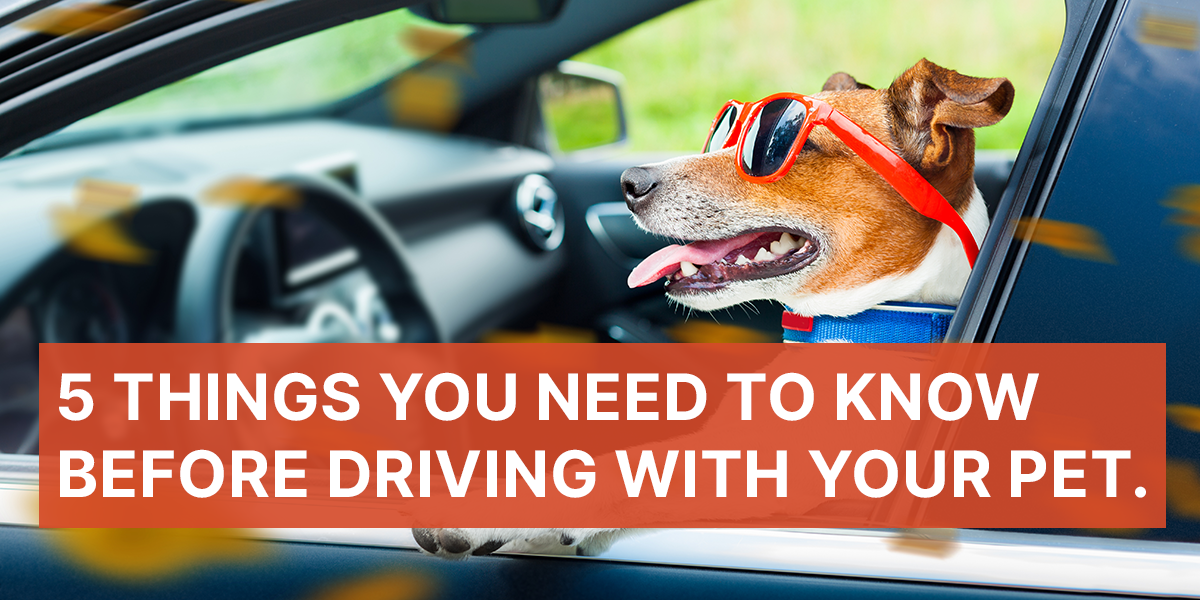Here are the 5 most important things you need to know before driving with your pet, to make sure you are fully prepared for any long journeys.

1. What is the law regarding driving with pets?
Did you know it is illegal to drive without your dog being correctly restrained?
Driving with dogs in the car is very common, but did you know drivers deemed distracted by their pets could be given an on-the-spot fine of £1,000 – £5,000 for careless driving and 9 penalty points depending on the severity of the breach. This could go as far as a driving ban, re-test or even jail time in some extreme cases.
Driving with pets is covered under Rule 57 of the Highway Code which states: “When in a vehicle make sure dogs or other animals are suitably restrained so they cannot distract you while you are driving or injure you, or themselves, if you stop quickly. A seat belt harness, pet carrier, dog cage or dog guard are ways of restraining animals in cars”.
2. What does my insurance cover?
You may be wondering, what does my insurance cover in the event of an accident?
If your pet is found to have caused or contributed to an accident, your car insurance could be invalid, as well as any pet insurance. This means not only will you lose the insurance, but you will have extra to pay out in the form of fines and penalties.
Should you need to claim, your insurance provider will investigate what was happening during the accident. Should they find out your pet was unrestrained it is likely your claim will be refused, even if the accident was not your fault.
3. How to safely restrain your pet for travel.
As stated in Rule 57 of the Highway Code “A seat belt harness, pet carrier, dog cage or dog guard are ways of restraining animals in cars”. Generally, the safest and most secure option is to secure your pet in a travel crate. Not only does this ensure there is no chance of your pet moving around in the event of an accident, but commonly dogs feel more safe and secure in a boot crate which can help alleviate travel sickness.

We have a range of travel crates for almost every car on the market here. Don’t see your vehicle listed? Drop us an email and we will be able to advise on the best one for your car.
Dog guards and travel harnesses are also great options for vehicles that do not have enough boot space to secure your dog comfortably, these will prevent your dog from being able to climb through to the front seats and potentially cause an accident.

4. How can I make sure my pet is comfortable in the car?
Making sure your pet is comfortable is essential when travelling with them in the car. Long journeys can make them anxious, irritable and travel sick which is not only bad for them but can be distracting for the driver. Always have some of your pets’ blankets and favourite toys with them when travelling to help calm your dog when travelling.
Plenty of water
Car-specific bowls that are less likely to spill water are readily available online. Having water easily accessible for your dog will go a long way in calming them, just be careful they don’t drink too much as this could make them unwell.
Drive steady
It’s not a race. Especially important with older dogs, driving in a smooth, calm manner is the best way to make sure your dog does not get injured, or is sick over the back seat or boot of your car.
Regular breaks
On long journeys to prevent any accidents it is wise to take regular toilet breaks. This will allow your dog to stretch their legs, cool down with some fresh air, and go to the toilet if needed.
Travel sickness
For details on preventing travel sickness in dogs, make sure your pet is safe, and comfortable with travelling in a car. Click here to learn more.
5. When not to travel with your pet
Although obvious, it is best not to travel with your dog if they are seriously unwell or injured if possible. Try not to travel with your dog if currently:
Your pet is sick/unwell
Your dog is injured. Moving around in the back/boot of a car could cause them further injury.
If your pup is a newborn.
Your pet is heavily pregnant or recently gave birth.

